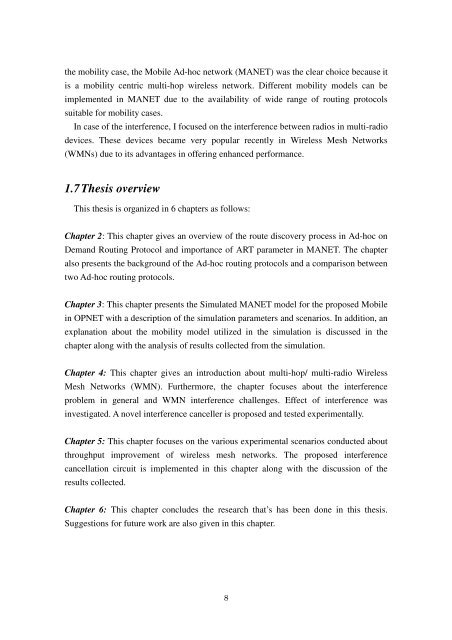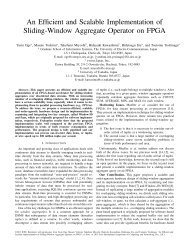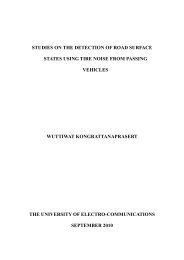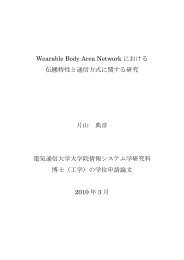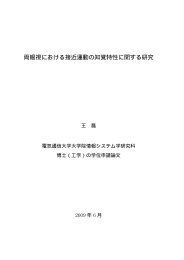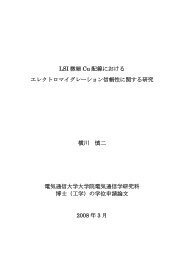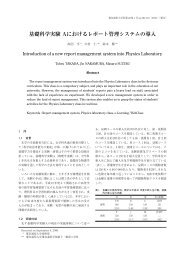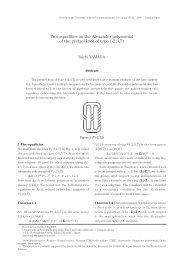a study on the spectrum efficient multi-hop wireless network
a study on the spectrum efficient multi-hop wireless network
a study on the spectrum efficient multi-hop wireless network
Create successful ePaper yourself
Turn your PDF publications into a flip-book with our unique Google optimized e-Paper software.
<strong>the</strong> mobility case, <strong>the</strong> Mobile Ad-hoc <strong>network</strong> (MANET) was <strong>the</strong> clear choice because it<br />
is a mobility centric <strong>multi</strong>-<strong>hop</strong> <strong>wireless</strong> <strong>network</strong>. Different mobility models can be<br />
implemented in MANET due to <strong>the</strong> availability of wide range of routing protocols<br />
suitable for mobility cases.<br />
In case of <strong>the</strong> interference, I focused <strong>on</strong> <strong>the</strong> interference between radios in <strong>multi</strong>-radio<br />
devices. These devices became very popular recently in Wireless Mesh Networks<br />
(WMNs) due to its advantages in offering enhanced performance.<br />
1.7 Thesis overview<br />
This <strong>the</strong>sis is organized in 6 chapters as follows:<br />
Chapter 2: This chapter gives an overview of <strong>the</strong> route discovery process in Ad-hoc <strong>on</strong><br />
Demand Routing Protocol and importance of ART parameter in MANET. The chapter<br />
also presents <strong>the</strong> background of <strong>the</strong> Ad-hoc routing protocols and a comparis<strong>on</strong> between<br />
two Ad-hoc routing protocols.<br />
Chapter 3: This chapter presents <strong>the</strong> Simulated MANET model for <strong>the</strong> proposed Mobile<br />
in OPNET with a descripti<strong>on</strong> of <strong>the</strong> simulati<strong>on</strong> parameters and scenarios. In additi<strong>on</strong>, an<br />
explanati<strong>on</strong> about <strong>the</strong> mobility model utilized in <strong>the</strong> simulati<strong>on</strong> is discussed in <strong>the</strong><br />
chapter al<strong>on</strong>g with <strong>the</strong> analysis of results collected from <strong>the</strong> simulati<strong>on</strong>.<br />
Chapter 4: This chapter gives an introducti<strong>on</strong> about <strong>multi</strong>-<strong>hop</strong>/ <strong>multi</strong>-radio Wireless<br />
Mesh Networks (WMN). Fur<strong>the</strong>rmore, <strong>the</strong> chapter focuses about <strong>the</strong> interference<br />
problem in general and WMN interference challenges. Effect of interference was<br />
investigated. A novel interference canceller is proposed and tested experimentally.<br />
Chapter 5: This chapter focuses <strong>on</strong> <strong>the</strong> various experimental scenarios c<strong>on</strong>ducted about<br />
throughput improvement of <strong>wireless</strong> mesh <strong>network</strong>s. The proposed interference<br />
cancellati<strong>on</strong> circuit is implemented in this chapter al<strong>on</strong>g with <strong>the</strong> discussi<strong>on</strong> of <strong>the</strong><br />
results collected.<br />
Chapter 6: This chapter c<strong>on</strong>cludes <strong>the</strong> research that’s has been d<strong>on</strong>e in this <strong>the</strong>sis.<br />
Suggesti<strong>on</strong>s for future work are also given in this chapter.<br />
8


